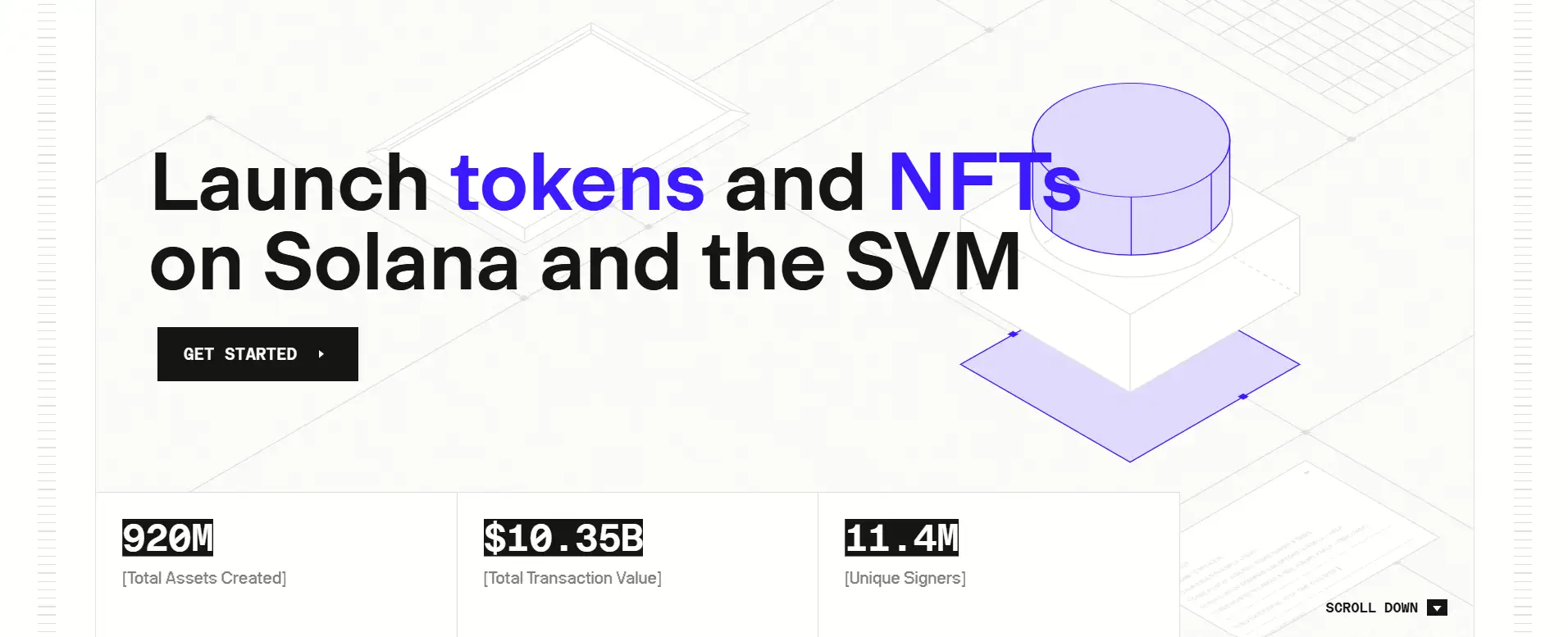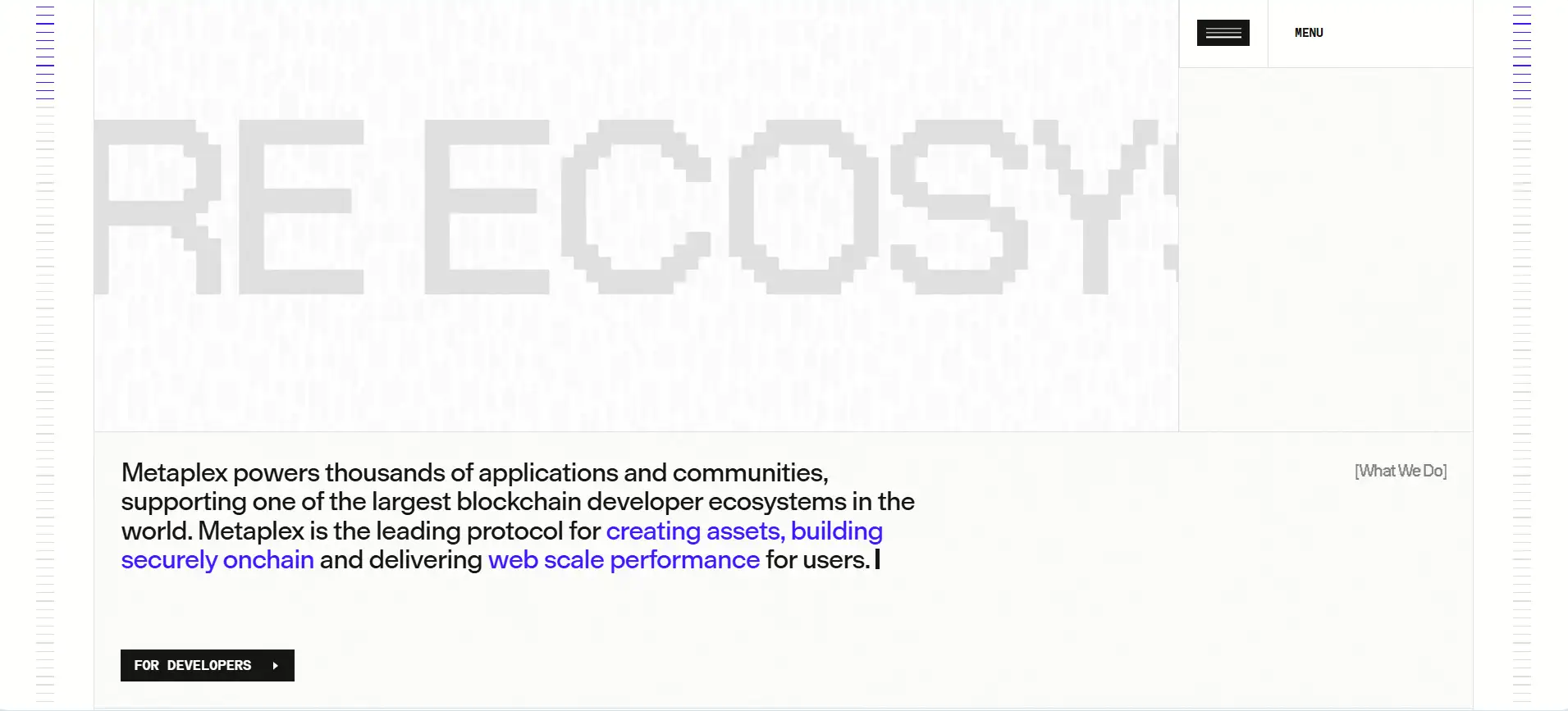About Metaplex
Metaplex is a powerful decentralized protocol built on the Solana blockchain, offering essential infrastructure for the creation, management, and use of digital assets. It serves as the foundational layer for developers and creators launching tokens, NFTs, and other onchain assets within the Solana ecosystem. With over 920 million assets created and more than $10 billion in transaction volume, Metaplex has become the go-to digital asset protocol for applications ranging from DeFi and gaming to DePIN and RWAs.
Used by nearly every wallet and asset project on Solana, Metaplex provides battle-tested standards and tools that enable scalable, composable digital economies. Its components include the Metaplex Digital Asset Standard (DAS), the Metaplex Program Library (MPL), and the DAS API, each designed to help developers build secure, performant applications with minimal complexity.
The vision behind Metaplex is to create an open, developer-first protocol that provides the infrastructure for tokenization at scale on Solana and the Solana Virtual Machine (SVM). Since its inception, Metaplex has established itself as the dominant force in Solana’s digital asset ecosystem, powering virtually all NFTs and tokens in circulation. The platform is utilized by major projects and tools such as Solflare, Claynosaurz, Triton, and Eclipse, each of which relies on Metaplex’s high-performance tooling and read infrastructure to support production-ready applications.
At its core, Metaplex simplifies complex blockchain development through its modular suite of tools. The Digital Asset Standard (DAS) acts as Solana’s equivalent of Ethereum’s ERC-20 and ERC-721 standards, governing how digital assets are created and behave. The Metaplex Program Library (MPL) offers audited, reusable smart contracts that enable asset creation, management, sales, and royalties. Meanwhile, the DAS API provides a powerful interface for querying onchain data across compressed and uncompressed NFTs and fungible tokens.
Metaplex’s decentralization roadmap continues with the introduction of Aura, a decentralized read layer that replaces traditional indexers with scalable, cost-efficient data access. These efforts ensure that Metaplex remains not only performant but also aligned with the open principles of blockchain architecture.
Its strongest competitors include the Ethereum-based OpenSea and Rarible protocols, which offer similar asset minting and trading functionalities. However, Metaplex’s deep integration with Solana and focus on performance and scalability make it a more tailored choice for apps requiring web-scale blockchain performance.
Metaplex provides numerous benefits and features that make it a standout platform in the blockchain asset infrastructure space:
- Industry Standard on Solana: The Digital Asset Standard (DAS) governs nearly all token and NFT issuance on Solana, making Metaplex an integral part of the network's digital economy.
- Modular Program Library: The Metaplex Program Library (MPL) enables developers to build asset creation, sales, and distribution flows without starting from scratch.
- High-Performance DAS API: A unified API for reading asset data across all types of Solana-based digital assets—fungible, non-fungible, and compressed.
- Aura Decentralized Read Layer: Eliminates centralized indexing points, supporting a more decentralized and resilient data access layer.
- Developer-Friendly Tooling: Robust CLI, SDKs, and guides to streamline development across Rust and TypeScript ecosystems.
- Real Ecosystem Adoption: Used by leading projects and wallets like Solflare, Claynosaurz, Triton, and Eclipse.
Metaplex makes it easy for developers to launch, manage, and scale digital assets on Solana:
- Visit the Developer Hub: Start at the official Metaplex site to explore the developer section and access core components like the MPL and DAS API.
- Learn the Standards: Read up on the Digital Asset Standard (DAS) to understand asset structures and capabilities.
- Use the Program Library: Integrate audited Solana programs from the MPL to mint NFTs, tokens, or launch DeFi use cases with minimal risk.
- Explore the SDKs: Install and configure SDKs for TypeScript and Rust, or use the CLI tools to deploy directly from your terminal.
- Query Data with the DAS API: Set up calls to the API to pull asset data, metadata, and owner information directly into your dApp.
- Join the Community: Get real-time help and support by joining the Metaplex Discord server, where contributors and builders collaborate.
- Check the Guides: Follow official guides to create Solana NFTs, tokens, hybrid collections, and integrate CPI calls.
Metaplex FAQ
While ERC-721 focuses primarily on NFT ownership on Ethereum, the Metaplex Digital Asset Standard (DAS) enables much more on Solana. DAS supports a broader range of asset types—such as fungible tokens, compressed NFTs, and DePIN assets. Unlike static token formats, Metaplex offers composability, scalability, and support for programmatic interaction across multiple Solana programs.
The Metaplex DAS API acts as a powerful data access layer that allows developers to read digital asset data on Solana efficiently. Whether you're querying metadata for NFTs, balances of fungible tokens, or ownership records, the DAS API provides real-time, unified endpoints. This simplifies backend development and improves dApp responsiveness across large user bases. Explore it via Metaplex.
Yes, Metaplex allows for hybrid 404 collections and other dynamic formats, blending the traditional NFT model with programmatically mutable data. Developers can use smart contracts and metadata updates to build assets that change over time—ideal for gaming, seasonal drops, or DePIN use cases. This flexibility gives creators a new layer of expression and functionality.
Aura is a decentralized read layer introduced by Metaplex to replace traditional centralized indexers. It eliminates single points of failure in data querying and offers high-performance, low-cost access to onchain data. Aura supports better uptime, faster responses, and greater censorship resistance, making it a crucial upgrade for mission-critical Web3 applications.
Metaplex isn’t just for NFTs. Developers can launch fungible tokens, RWAs, DePIN assets, gaming assets, and even more experimental formats directly on Solana using the Metaplex Program Library. Its modular design lets teams integrate these assets into DeFi, games, and marketplaces. Learn more by exploring the developer section on Metaplex.
You Might Also Like












